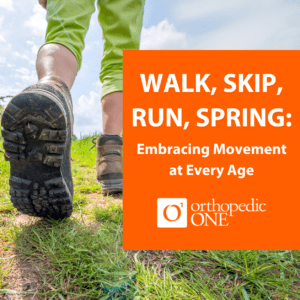Walk, Skip, Run, Spring: Embracing Movement at Every Age
As adults, life gets busy, and it can be difficult to fit exercise into your daily routine. But, embracing an active lifestyle is vital for maintaining our physical and mental health as we age. With some tips and adjustments, daily movement can become a meaningful habit, not just a hobby.
At Orthopedic ONE, we know that lifelong movement is not just about staying fit; it’s about sustaining your musculoskeletal health. Regular physical activity strengthens the muscles and joints, enhances flexibility, and improves balance, all of which are essential for reducing the risk of falls and injuries. Investing in your movement today means investing in a healthier, more resilient tomorrow.

Making Movement a Habit
No matter your physical activity level, incorporating regular exercise into your routines can have a profound impact. According to the American Society of Bone and Mineral Research, by age 30, adults begin to lose muscle mass and strength. This loss can be especially apparent for women, who begin to lose muscle, bone, and cartilage mass as they approach menopause and their estrogen levels drop. However, moderate exercise and a balanced diet can help combat these losses and provide you with additional health benefits.
Regular exercise has consistently corresponded with decreased feelings of anxiety and improved mood. A study in the Journal of Aging and Physical Activity found that during exercise, the body’s central and sympathetic nervous systems communicate more effectively, allowing the body to adapt to stress more easily long term.
Staying Active as You Age
Though an active lifestyle looks different for everyone, it is an important factor in maintaining your long-term health. As you age, your range of motion (the ability to move a joint in all possible directions) decreases. In fact, inactivity is the most common cause of decreased range of motion, and it can increase your likelihood of muscle atrophy, joint pain, fall risk, and other injuries. Ouch!
The CDC recommends 150 minutes of moderate cardio a week for adults, and this can be anything that gets your heart rate up! Whether it be running, swimming, biking, or even daily activities such as raking leaves or taking the dog for a walk, getting your body moving will keep your heart healthy and provide confidence in your long-term health.
One of the most important benefits of strength training is that it allows you to maintain the day-to-day activities that get more difficult with aging, such as lifting bags of groceries or picking up your grandchildren. Incorporating strength training into your weekly workout plan will help prevent muscle loss as you age. When beginning strength training, it’s important to start small. Exercise bands or small hand weights make a great addition to any workout, and ankle weights can be added during a walk or yoga session. If you don’t have any equipment on hand, you can use soup cans, water bottles, or try bodyweight exercises such as lunges or squats.
Balance exercises such as yoga or tai chi are also great options for preventing injury. By increasing stability, flexibility, and reaction time, these exercises can help reduce the risk of falls, which often result in more serious issues such as sprains or breaks. You can try balance exercises anywhere: in your home, at the park, or in the gym. All you need is you—no equipment necessary!
Small Changes, Lifelong Results
Considering the importance of an active lifestyle, finding small ways to incorporate exercise into your daily habits can have serious benefits. Having trouble getting started? Try incorporating a few of these simple tips, and you will be on the path to success in no time!
Create an Activity Schedule
Maintaining an active lifestyle will be an easier adjustment if you can anticipate what to expect. Writing down and planning activities for the early morning, after work, or after dinner will help you incorporate daily activity into your lifestyle.
Find a Local Gym
A membership to a gym or rec center can help you stay active and find a support system. Many gyms offer classes that target specific needs, especially for aging adults, and can provide variety that can be difficult to find during solo workouts.
Stretch Regularly
Our tendons get thicker and less elastic with age, making you more prone to injuries. However, stretching can help counteract this process and prepare you for activity by keeping muscles flexible. Incorporate stretching before bed, as well as during your warm-up and cool-down, to reduce your risk of injury and keep your body moving for years to come.
Don’t forget—when you’re incorporating an active lifestyle into your daily routine, start small. Slow changes will be more effective than sudden ones. Not only does gradually increasing the frequency and intensity of your workouts make your active lifestyle more sustainable, but it also decreases the risk of injury that can occur from doing too much too soon.
Your number one goal is to find an athletic activity that you enjoy! Anything that gets you moving, including walking a pet, gardening, or playing with the grandkids, is a beneficial addition that will keep you accountable and healthy as you age.
At Orthopedic ONE, your health is our mission. We’re here to support you, no matter where you may be in your journey. Schedule an appointment today and take the first step toward a healthier, more active lifestyle with the guidance of one of our experienced physicians.
Sources: